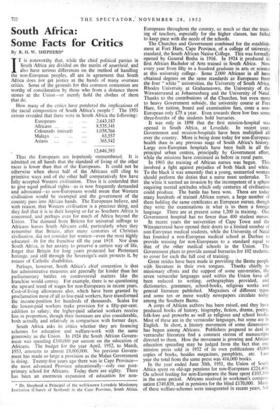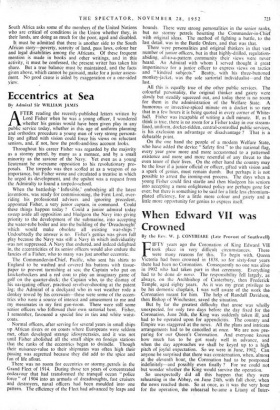South Africa: Some Facts for Critics
By R. H. W. SHEPHERD*
IT is noteworthy that, while the chief political parties in South Africa are divided on the merits of apartheid, and also have serious differences on the method of handling the non-European peoples, all are in agreement that South Africa does not get justice at the hands of many overseas critics. Some of the grounds for this common contention are worthy of consideration by those who from a distance throw stones at the Union—or merely hold the clothes of them that do.
How many of the critics have pondered the implications of the racial composition of South Africa's people ? The 1951 census revealed that there were in South Africa the following: Europeans 2,643,187 Africans ... 8,535,341 Coloureds (mixed) 1,038,766 Malays ... 63,557 Asians ... 365,542 • 12,646,393 Thus the Europeans are hopelessly outnumbered. It is admitted on all hands that the standard of living of the other races is lower than that of the Europeans. It could not be otherwise when about half of the Africans still cling to primitive ways and of the other half comparatively few have fully accepted Western civilisation. Thus it is contended that to give equal political rights—as is now frequently demanded and advocated—to non-Europeans would mean that Western civilisation would be swamped and the government of the country pass into African hands. The Europeans believe, and with reason, that Western civilisation is a precious thing, and they feel that it is in their keeping so far as Southern Africa is concerned, and perhaps even for much of Africa beyond the Union. The demand from Britons for universal suffrage to Africans leaves South Africans cold, particularly when they remember that Britain, after many centuries of Christian civilisation, did not consider her women—even the most highly educated—fit for the franchise till the year 1918. Nor does South Africa, in her anxiety to preserve a certain way of life, forget that Britain for long years protected her Protestant heritage, and still through the Sovereign's oath protects it, by means of Catholic disabilities.
Perhaps, however, South Africa's chief contention is that her administrative measures are generally far kinder than her parliamentary battles on controversial matters like the franchise would convey. For example, there is no questioning the upward trend of wages for non-Europeans in recent years. Cost-of-living allowances also, which have been granted by proclamation most of all to low-paid workers, have transformed the income-position for hundreds of thousands. Scales for the lowest-paid workers make provision for a fifty-per-cent. addition to salary; the higher-paid salaried workers receive less in proportion, though their increases are also considerable, both actually and relatively in comparison with former days.
South Africa asks its critics whether they are financing schemes for education and welfare7work with the same generosity as the Union. In 1924 the South African Govern- ment was spending £340,000 per annum on the education of Africans. The budget for the year April, 1952, to March, 1953, amounts to almost £8,000,000. No previous Govern- ment has made so large a provision as the Malan Government is doing. Twenty-five years ago there was in Cape Province— the most advanced Province educationally—only one post- primary school for Africans. Today there are eighty. There has been an enormous expansion of education for non-
* Dr. Shepherd is Principal of the well-known Lovedale Missionary Institution (Church of Scotland) in the Cape Province, South Africa.
Europeans throughout the country, so much so that the train- ing of teachers, especially for the higher classes, has failed to keep pace with the needs of the schools.
The Churches and Government combined for the establish- ment at Fort Hare, Cape Province, of a college of university standard, the South African Native College. This was formally opened by General Botha in 1916. In 1924 it produced its first African Bachelor of Arts trained in. South Africa. Now every year from fifty to a hundred graduate in arts or science at this university college. Some 2,000 Africans in all have obtained degrees on the same standards as Europeans from the four " white " universities, the University of South Africa. Rhodes University at Grahamstown, the University of the Witwatersrand at Johannesburg and the University of Natal. Thanks to the contributions of the Churches, but even more to heavy Government subsidy, the university course at Fort Hare, for tuition, board and examination fees, costs a non. European only £75 a year. Even towards these low fees some three-fourths of the students hold bursaries.
It was only in 1898 that the first mission-hospital was opened in South Africa,. at Lovedale. In recent years Government and mission-hospitals have been multiplied all over the country. More is being done today for non-European health than in any previous stage of South Africa's history.
Large non-European hospitals have been built in all the principal urban centres, principally by Government effort, while the missions have continued as before in rural parts.
In 1903 the training of African nurses was begun. This involved a fight against prejudice of both black and white. To the black it was unseemly that a young, unmarried woman should perform the duties that a nurse must undertake. To the white it seemed an invasion by the incompetent of a sphere requiring mental aptitudes which only centuries of civilisation could produce. The battle has been won. There are today many hundreds of trained African nurses, a large number of them holding the same certificates as European nurses, though they write the examinations in what is to them a foreign language. There are at present some 1,200 in training. One Government hospital has no fewer than 400 student nurses.
In recent years the universities of Cape Town and the Witwatersrand have opened their doors to a limited number of non-European medical students, while the University of Natal has founded a non-European medical school at Durban to provide training for non-Europeans to a standard equal to that of the other medical schools in the Union. The Government plans to provide annual bursaries for 102 students, to cover for each the full cost of training. - Great strides have been made in providing the Bantu people with literature in their own tongues. Thanks chiefly to missionary efforts and the support of some universities, the seven vernacular languages used within the Union have all been reduced to writing, orthographies provided, and dictionaries, grammars, school-books, religious works and general literature published. Magazines of different- types and some ten or more weekly newspapers circulate today among the Southern Bantu. A corps of African authors has been raised,- and they have produced books of history, biography, fiction, drama, poetry, folk-lore and proverbs as well as religious and school books. Most of these are in the vernacular languages, but some are in English. In short, a literary movement of some dimensions has begun among Africans. Publishers prepared to deal in vernacular literature find a constant stream of manuscripts directed to them. How the movement is growing and African education spreading may be judged from the fact that one mission press sold in 1932 of its own publications 43,000 copies of books, besides magazines, pamphlets, etc. Last year the total from the same press was 416,000 books. In the year ended June 30th, 1951, the Union of South Africa spent on old-age pensions for non-Europeans £224,400. On school feeding for non-Europeans the State spent £103,100 in the same period. Africans received in workmen's compen- sation £749,839, and in pensions for the blind E170,000. Many of these welfare-schemes were inaugurated in recent years, but South Africa asks some of the members of the United Nations who are critical of conditions in the Union whether they, in their lands, are doing as much for the poor, aged and disabled.
It must be admitted that there is another side to the South African story—poverty, scarcity of land, pass laws, colour bar and legal disabilities among the Africans. Of these frequent mention is made in books and other writings, and in this activity, it must be confessed, the present writer has taken his share. But a true balance must be maintained, and the facts given above, which cannot be gainsaid, make for a juster assess- ment. No good cause is aided by exaggeration or a one-sided yiew.



































 Previous page
Previous page